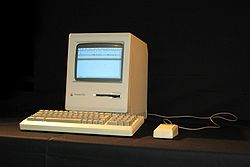
Allow me to introduce myself: I'm Ken Gruberman, The Tech Daddy. I've been answering questions and writing about personal technology since 1991. And now, it's my honor to be here on the Huffington Post. I look forward to being your trusty guide, advisor and wise-cracking sidekick as you hack your way through the Tech Jungle!
So, how did I become the Tech Daddy? Let's go back to where it all started.
They say (whoever "they" are) that the first kind of computer you try is the one you like the best, and the one you stick with. I'm not sure that's true: my first personal computer was a Commodore 64... and I hated it! For 3 years I struggled to get it to do just about anything, although it did have a certain charm. But what did I expect from a computer I bought at Toys 'r Us? It wasn't as if I didn't understand computers: I'd gone to UCLA and CalTech, and learned FORTRAN when I was 14. But to me, this Commodore 64 was beyond hopeless.
Even though I had a heavy science and technology-based education, my long-standing profession is in the field of music preparation. For 42 years I've been called a "music copyist," although no one -- other than other music copyists -- really knows what that means. Basically, we are the people whose job it is to get the music out of the head of the composer or arranger or orchestrator and onto the page. I produce the actual parts and scores used by musicians in recording or performance for film, TV, records and concerts; the complete success or failure of the project rests on my shoulders. Music copyists are an amalgam of engraver, editor, composer and artist. Mozart and Beethoven had copyists. It is an exacting, demanding and arcane job that remained unchanged for hundreds of years.
 But then, in 1987, everything changed -- both for me and for music preparation. I saw a demo of a music notation program called Professional Composer. The computer it ran on was an Apple Macintosh. I knew this was the future, and was determined to embrace it. I bought a Mac Plus that weekend and did more with it in 3 days than the previous 3 years with the Commodore. This was geek love!
But then, in 1987, everything changed -- both for me and for music preparation. I saw a demo of a music notation program called Professional Composer. The computer it ran on was an Apple Macintosh. I knew this was the future, and was determined to embrace it. I bought a Mac Plus that weekend and did more with it in 3 days than the previous 3 years with the Commodore. This was geek love!
I became the first studio copyist in Los Angeles to adopt computer-based notation. It was tough going, and the dot-matrix printer I was using produced horrible-looking music. I was derided -- and rightfully so -- by some big-name studio musicians... but I stuck with it. Today, you'd be hard-pressed to find any professionals in L.A. that still writes music by hand.
The more adept I became with Professional Composer, the more facile I became with the Mac. I soon joined the MacValley Users Group in Northridge, CA to expand my Mac knowledge in specific, and computer knowledge in general. That's when things really took off for me. In short order I became the Program Chair (I booked the presenters each month), the meeting MC, and the editor of the newsletter -- positions I held for 14 years. I participated in panel discussions and roundtables at both the San Francisco-based Seybold Seminars and MacWorld Expo. In the early 90s, I started writing for MacUser magazine; over the course of almost 7 years I contributed dozens of reviews, articles and features.
In the early 90s I added PCs to my repertoire, as there were things I wanted to do that could only be done with a Windows-based system. I built my own PC as a way to learn about them, and also started integrating the two platforms and helping others with similar tasks.
And I got into the wider field of personal technology. I'd always been an audiophile since the age of 12, so it was natural I get the very first CD player when it was offered to the public. I was an early adopter of both Laserdiscs in the 80s and DVDs and TiVO in the 90s -- the digital video recorder (DVR) and service that defined the industry. I still have and use a TiVO; I love my Series 3! And now TiVO has announced Series 4 machines (but that's another column.)
Cellphones, digital cameras, PDAs and handheld devices, audio and video... if it spins, beeps or blinks, chances are I've either had it or have it.
Now we're completing our first decade of the 21st century, and the Tech Train is rolling at an ever-faster pace. Do I feel bitter about not getting my personal Jet Pack and Jetsons HoverCar when Y2K came? Of course! After all, Popular Mechanics said we'd all have them, right? Liars. Still, there are plenty of technological wonders to amaze us all. One of them is Sibelius, the notation software I currently use; I've been a fan for several years, and enjoy occasionally demoing the product.
I'm also a huge fan of my wife, Ellen Snortland, who came up with the name "Tech Daddy" soon after we met in 2007. Ellen has a way with words; if you read her posts here on Huffington you already know this!
What can you count on from me? The unvarnished truth, because I'm still in the tech trenches every day with all of you. Some humor to go with it. A wide range of topics to talk about. And I'll go the extra mile to answer your questions. Which, by the way, you can submit by sending an email to me at ken@thetechdaddy.com. Be sure and put "HuffPo Question" in the subject line (without the quotes, of course.)
I look forward to hearing from you! Now where did I leave my HoverCar?
